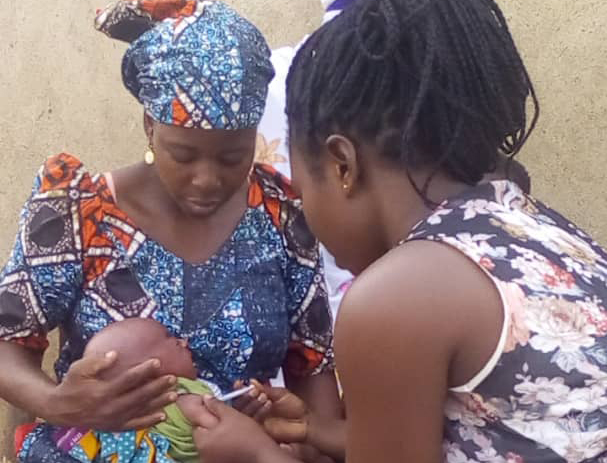The Impact of Text-Message Reminders and Small Rewards on Timely Vaccination Coverage in Northern Ghana

Abstract
Despite major global progress in vaccination coverage, many children and young infants are vaccinated late, leaving them susceptible to life-threatening, preventable illnesses. In Ghana, researchers conducted an evaluation to investigate the impact of mobile phone-based reminders and an incentive system on early vaccination coverage and timely documentation of births. Results show that incentives increased on-time infant vaccination by 49.5 percentage points. Reminders had a smaller but still significant impact, increasing on-time infant vaccination by 10.5 percentage points.
Policy Issue
Despite major progress globally in child vaccination coverage overall, many children and young infants are vaccinated late, leaving them susceptible to experiencing life-threatening, preventable diseases. Previous research suggests that mobile phone-based reminders can increase medication adherence and attendance at health care appointments, but evidence on the impact of such reminders on accessing preventive services is more limited.
Incentive and small reward systems for households or individuals, and for healthcare workers, have also been effective in improving immunization coverage. For example, results from India suggest that even small rewards can result in substantial increases in vaccination uptake.1 This project built on the evidence from India to evaluate a novel intervention approach in rural communities in northern Ghana.
Context of the Evaluation
In Ghana, 97 percent of children receive the Bacillus Calmette-Guérin (BCG) vaccine to provide protection against tuberculosis within the first year of life, and 79 percent of children receive the first dose of the polio vaccination, typically given at birth.2 But coverage of early vaccinations varies considerably by setting, and is lower in regions where women often deliver at home, as is the case in Ghana’s Northern region. Only 58 percent of children in the Northern region receive the first dose of the polio vaccine.3
Community health volunteers are charged with documenting births and providing health information for new mothers. However, because community health volunteers (CHVs) are not formally associated with the Ghana Health Systems and do not get compensated for their work, birth reporting and registration is low.4 This makes it difficult for the health systems to connect with new mothers for vital neonatal vaccination. Recent research conducted in this region shows that the large majority of households have access to mobile phones, even in the most rural areas.5 This project used mobile phones to address two of the biggest bottlenecks in vaccine delivery: documentation of births and late vaccination.
Details of the Intervention
Researchers conducted an evaluation (pilot cluster randomized controlled trial) in the Karanga region of northern Ghana to assess the impact of mobile phone reminders and reward systems on early vaccination coverage rates and timely documentation of births. A total of 15 communities were randomly assigned into three groups:
- Voice call reminder (Five communities): Community health volunteers documented and reported births in the community. New mothers received a voice call from central study staff highlighting the importance of early vaccinations, encouraging them to get their newborns vaccinated, and informing them of available opportunities in their communities to receive vaccination for their newborns.
- CHV + Incentives (five communities): Community health volunteers documented and reported births in the community. New mothers received encouragement from the community health volunteer in person or via phone, voice message, or text message to complete recommended vaccinations. If the vaccinations were successfully completed on time, mothers and community volunteers each received an incentive via a mobile banking app.
- Comparison group (five communities): No active intervention was provided for new mothers. The communities’ regular health and vaccine services continued.
The intervention took place between November 2018 and April 2019. In July 2019, researchers conducted household surveys to assess vaccination coverage before and after the intervention launch. They also documented the number of live births that occurred in the previous year and documented all infants up to 12 months of age residing in the community, or born in the previous 12 months and deceased.
Results and Policy Lessons
Incentives significantly increased on-time infant polio and BCG vaccination by 49.5 percentage points. Reminders had a smaller but still significant impact, increasing on-time infant vaccination by 10.5 percentage points.
Polio Vaccination Impacts: The impacts on on-time infant vaccination were driven entirely by polio vaccinations. Incentives increased on-time first-dose polio vaccination by 48.8 percentage points relative to the comparison group. Voice call reminders increased infant vaccination by 10.7 percentage points, only slightly higher than the comparison group.
BCG Vaccination Impacts: Neither incentives nor voice call reminders had any impact on on-time BCG vaccination relative to the comparison group.
Number of Births and Birth Reporting: Researchers documented 693 live births before and during the intervention, with 690 surviving to at least one day of life. Of the 690 infants, 211 were born in the incentive group communities (88 pre-intervention; 123 intervention period), 223 were born in the voice reminder group communities (88 pre-intervention; 135 intervention period), and 256 were born in the comparison group communities (106 pre-intervention; 150 intervention period).
During the intervention, the community health volunteers identified and reported 71 percent of births in the voice call reminder communities (96 out of 135 births) and 67 percent of births in the incentives communities (82 out of 123 births).
Sources
1. Banerjee, Abhijit Vinayak, Esther Duflo, Rachel Glennerster, and Dhruva Kothari. "Improving immunisation coverage in rural India: clustered randomised controlled evaluation of immunisation campaigns with and without incentives." Bmj 340 (2010).
2,3. Ghana Demographic and Health Survey. 2014. Ghana Statistical Service, Ghana Health Service, and ICF International. https://dhsprogram.com/pubs/pdf/fr307/fr307.pdf
4. Dake, Fidelia AA, and Kamil Fuseini. "Registered or unregistered? Levels and differentials in registration and certification of births in Ghana." BMC international health and human rights 18 (2018): 1-9.
5. Williams, Idongesit, and Benjamin Kwofie. "The Impact of Liberalization on the Mobile Telephony Market in Africa: the Cases of Ghana, Nigeria and Kenya." In The African Mobile Story, pp. 17-40. River Publishers, 2022.











